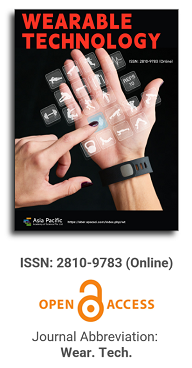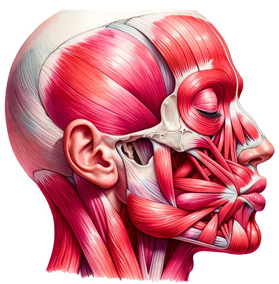

This paper delves deeply into the innovative realm of integrating human emotions with wearable technology. The primary focus is on the conceptualization and development of a kiss transfer device that harnesses the power of wearable technology to bridge the physical gap in human-human interactions. By investigating the intricate nuances of the human-human kissing process, the research seeks to replicate this intimate gesture through a technological medium. The paper not only elaborates on the anatomy, evolution, and hormonal dynamics of kissing but also underscores the transformative potential of wearable technology in capturing and transmitting these intimate moments. This exploration opens up new horizons for long-distance relationships, offering a tangible touchpoint that goes beyond traditional communication methods. Through this pioneering work, the research positions wearable technology as not just a tool for communication but as an extension of our human emotions and expressions.

Implantation of permanent pacemakers in Cuenca–Ecuador, from 2017 to 2018
Vol 1, Issue 2, 2020
Download PDF
Abstract
Introduction: In recent years, the placement frequency of permanent pacemakers has increased due to some risk factors, some of which are carried out through cables. Objective: To determine the prevalence and related factors of permanent pacemaker implantation in adult patients in the cardiology department of José Calasco Artega hospital in 2017. Methods: a randomized cross–sectional study was conducted on 422 patients over 18 years old in the cardiology department of “José Carrasco Arteaga” hospital in Cuenca, Ecuador from January to December 2017. Information is processed in SPSS software version 24. Descriptive statistical analysis based on frequency and percentage was used to measure the statistical correlation with odds ratio (or) within 95% confidence interval. When p<0.05, it was considered to be statistically significant. Results: The implantation rate of cardiac pacemaker was 7.1%, and the average age was 65.52 years (DS±14.77), mainly male. The risk factors associated with pacemaker implantation were atrioventricular block or 42.56 (95% confidence interval: 16.06–112.73, p=0.000); Sinoatrial node disease or 59.34 (95% CI: 11.67–301.93, P=0.000) and others or 0.017 (95% confidence interval: 0.00–0.05, p=0.000). Atrial fibrillation was not statistically significant or 1.71 (95% confidence interval: 0.62–4.71, p=0.354). Conclusion: The prevalence of pacemaker implantation is 7.1%, which is related to atrioventricular block, which is the main risk factor, followed by nodular diseases.
Keywords
References
- Ramirez L, Segura L, Chunllo R. Marcapaso unicameral con simulación bicameral: presentación de un caso [Single chamber pacemaker and two chamber simulation: a case report]. Camagui Medical Records 2012; 16(5): 637–643.
- Khilnani VL, Femenia J,Arce M, et al. Complicaciones del implante de marcapaso definitivo. ¿Unevento operador dependiente? Análisis de 743 pacientes consecutivos [Event related operators?]. Analysis of 743 consecutive inpatients Mexican heart disease archives 2010; 80(2): 95–99.
- Garc í AE, siles S.Síndrome de Marcapaso en paciente con Síndrome [Patients with pacemaker syndrome]. Journal of Medical Sciences Chinese Academy of Sciences 2012; 16(1): 43–46.
- Bradyar. Bradiarritmias y bloqueos de la conducción [Rhythmia and conduction block]. Spanish Journal of Cardiology 2012; 65(7): 656–67.
- Pembo M, Cano O, Lorent D, et al. Resgistro español de marcapasos [Fifteenth report of the cardiac pacing ,Department of the Spanish Society of Cardiology]. Spanish Journal of Heartache2018; 71(15).
- Izaguirre S. Application of cardiac pacemaker in coronary artery nursing study conducted at Teodoro Maldonado hospital in 2016[Phd Thesis]. Dissertation Guayaquil: School of medicine, University of Guayaquil 2017.
- Pellegrini C,et al. Predictores de necesidad de marcapasos permanente y alteraciones de la conducción con elimplante transcatéter de una nueva válvula aórtica autoexpandible [Transcatheter implantation of a new self expandable aortic valve predicts permanent pacemaker demand and conduction disorders]. Spanish Journal of Cardiology 2018.
- Clinical and pacing mode of patients with pacemaker implantation alberto sabogal sologuren hospital in essalud, 2011–2014 [Phd Thesis]. Dissertation Lima, Peru: School of medicine, St. Martin de poles University 2015.
- Diaz MJP. Depression level and quality of life in patients with pacemaker implantation dissertation quito: School of psychological sciences. [Phd Thesis]. Central University of Ecuador 2015.
- L ó PEZ, Aguilera J, Segura Saint M, et al.Modificación de la conducción auriculoventricular tras e implante de prótesis aórtica CoreValve[Changes of atrioventricular conduction after aortic valve replacement]. Elsevier, Spanish Journal of Cardiology2016; 69(1): 28–36.
- Manfredi A, Albornoz H, gambogi R, et al. Seguimiento de marcapasos ycardiodesfibriladores [Follow up of pacemakers and defibrillators]. National Resources Fund 2011; 15(1): 15–22.
- Férnandez G, Maid GF, Martinez Arias A, et al. Prevalencia de fibrilación auriculary factores predictores de su aparición en pacientes portadores de marcapasos bicamerales [Prevalence and predictors of atrial fibrillation in patients with dual chamber pacemakers]. Elsevier. 2016; 3(86): 214–220.
- Cosedis Nielsen J, Johannessen A, Raatikainen P, et al. Radiofrequency Ablation as initial therapy inparoxysmal atrial fibrillation [Radiofrequency ablation as an initial treatment for paroxysmal atrial fibrillation]. New England Journal of Medicine 2012; 367(17): 1–9.
Supporting Agencies
Copyright (c) 2020 Brigitte Estefanía Secaira Neira, Hermel Medardo Espinosa Espinosa, Lizette Espinosa Martin, Zoila Katherine Salazar Torres, Juan José Solano Noblecilla

This work is licensed under a Creative Commons Attribution 4.0 International License.

Prof. Zhen Cao
College of Information Science & Electronic Engineering, Zhejiang University
China, China
Processing Speed
-
-
-
- <5 days from submission to initial review decision;
- 62% acceptance rate
-
-
Asia Pacific Academy of Science Pte. Ltd. (APACSCI) specializes in international journal publishing. APACSCI adopts the open access publishing model and provides an important communication bridge for academic groups whose interest fields include engineering, technology, medicine, computer, mathematics, agriculture and forestry, and environment.





